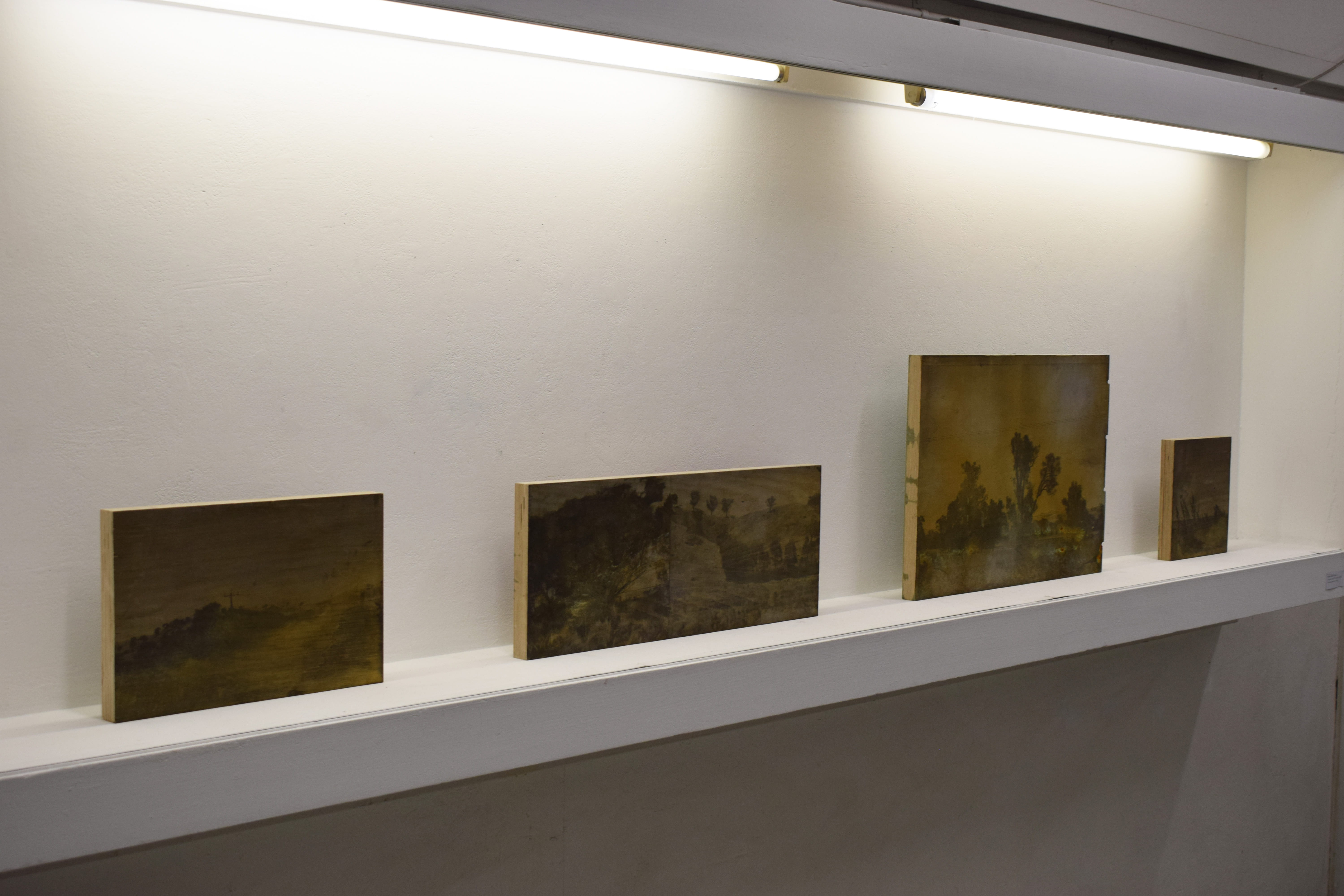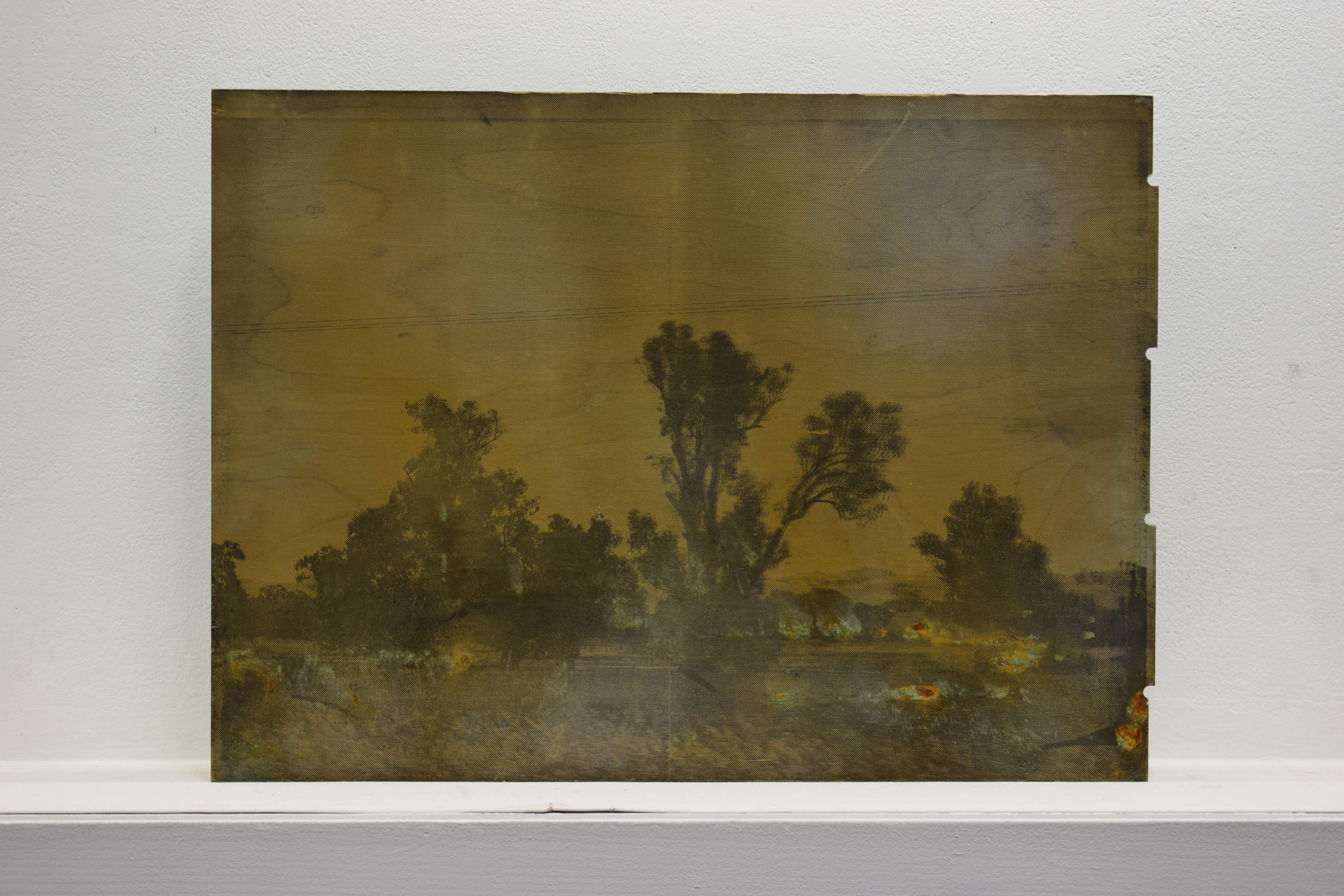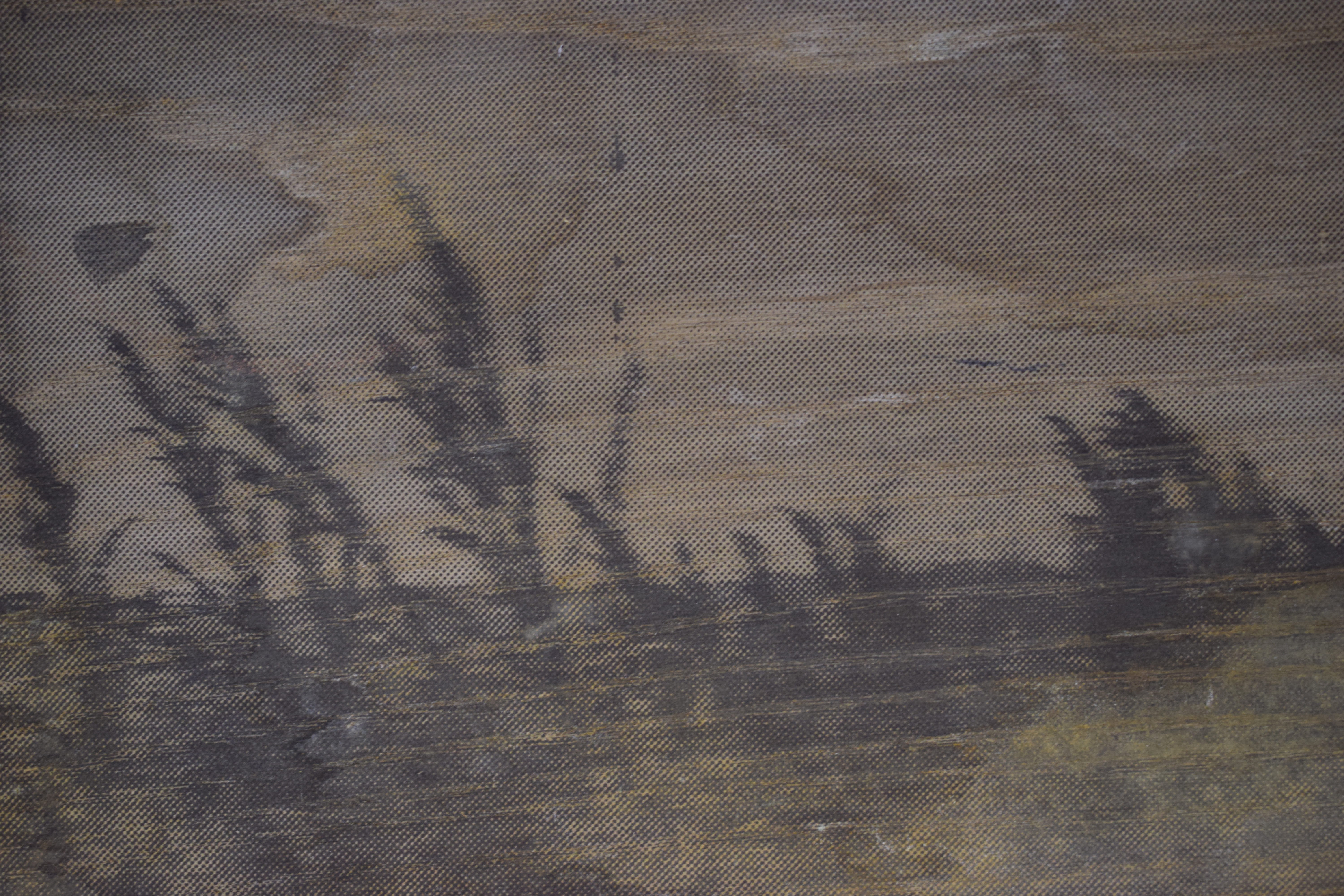Essay by Odin Strbac Low for Contextualising Practice
Acknowledgment
I pay my respects to the Traditional Custodians of the land in Naarm (Melbourne), including the Wurundjeri people of the Kulin Nation, as well as the Taungurung and Yorta Yorta peoples, whose historical landscapes have influenced the photographic elements in this essay’s discussion.
Essay
In the epoch of The Anthropocene[1], where human activities have profoundly altered the environment and led to the devastating destruction of natural ecosystems, my series Untitled (Rust Perception) is a response to pressing ecological concerns. Drawing inspiration from the philosophical ideas of Maurice Merleau-Ponty, this essay emphasises the significance of a thoughtful connection between our physical selves and the surrounding environment. Beyond this, it challenges the prevailing narratives of idealised landscapes, highlighting my work’s exploration of artificiality within the landscape and its commentary on detached consciousness.
Untitled (Rust Perception), presents a linear arrangement of four images, each with their own photographic element of landscape. This is what geographer and landscape theorist Cosgrove would refer to as a representational way of seeing, a work of art which treats landscape as its central subject (2008). The depicted scenes encompass elements such as trees, hills, powerlines, reeds, and various expanses of space. However, upon closer examination, the viewer discovers that these landscapes are screenprints, each with a halftone pattern; a cacophony of dots varying in proximity to one another to form a comprehensible image. Beneath the surface, subtle signs of wood grain emerge, characterised by sunken dashed lines that resisted the ink, becoming marks representing the material’s inherent irregularity.
Within my series, I employ a deliberate subversion of the inherent material properties of wood by integrating visual allusions to rust and the concept of decay. This disruption is entirely contrived, given that wood does not undergo the process of corrosion characterised by rust formation. Rust, typically caused by the interaction of moisture, iron, and oxygen, grows on surfaces and gradually erodes what lies beneath. As art historian Newman suggests, ‘can we even speak anymore of a natural landscape? The transformation is total and permanent…’ (Newman, cited in ‘The Art Seminar’ 2008:112). I reflected on this idea when selecting materials for my artwork, using acrylic patina to unnaturally reproduce the appearance of rust onto the landscape below. By disrupting the process of decay, these artificially rusted pieces of wood mirror the dry umber tones and rust stained terrain for which Australia is recognised.

Such characteristics of my artwork create a destabilised representation of reality through its photographic and material form, highlighting the significance of viewing landscape as a dynamic process. I acknowledge, as Mitchell has noted, that landscapes are an organising of the already encoded and cognisable field of reality for our bodily engagement (1994). This process of organisation is central to artistic utilisation and audience interpretation. Landscape artworks are deliberately framed, composed, and always visible, making them inseparable from our bodily experience. Similarly, the physical landscape itself is formed by cultural, social, and historical forces, as we shape the land, and are shaped by it. In this sense, landscape is as Williams has articulated, an ‘enamelled pastoral’, that which absorbs events unfolding on its surface (1973:18). Each layer forming an impermeable stasis, a complex relationship between past and present. As the background against which all historical and future events unfold, landscape holds significance across artistic disciplines, which is why I address it as the subject matter of my screenprints. While I have so far discussed some aspects of how my work engages with ‘exteriority’, I now invite you to shift your attention inward.
The concept of ‘interiority’ relates to our firsthand experiential understanding of the world as individuals – it encompasses our subjectivity. If the external world represents a visual encounter, ‘interiority’ encompasses the perception of being immersed in the environment through embodied, multisensory, and subjective means. It diverges from the traditional philosophical understanding of subjectivity found in thinkers like Descartes or Kant, where the subject is detached from reality. Instead, it is an embodied subjectivity, one where there is no position from which to master or dominate our experience (as noted in Merleau-Ponty 1968). As Newman highlights, Merleau-Ponty uses his phenomenological approach to depict the subject as a fold where there is an ‘…imbrication of the seeing and the seen, the touching and the touched’ (Newman, cited in ‘the Art Seminar’ 2008:112). The concept allows there to be an intertwining of mind and matter, emphasising the importance of being aware of this dynamic process. There is no ‘exteriority’ without the continual bodily engagement of each ‘interiority’ we as individuals possess.
Analysing the concept of ‘landscape’ as a fixed, visual document of ‘land’ presents challenges due to its inherent complexity rooted in the realm of perception. As Elkins points out, ‘like the body, landscape is something we feel ourselves to be inside. It’s our subject, but we’re also part of it: we help make it; we live in it’ (Elkins, cited in ‘the Art Seminar’ 2008:88). When approaching landscape from a phenomenological standpoint, it is important to consider the objective world together with subjective experience in reciprocity rather than distinctiveness. Merleau-Ponty captures this sentiment in the preface of his influential text, Phenomenology of Perception, expressing:
I am the absolute source, my existence does not stem from my antecedents, from my physical and social environment; instead it moves out towards them and sustains them, for I alone bring into being for myself (and therefore into being in the only sense that the word can have for me) the tradition which I elect to carry on, or the horizon whose distance from me would be abolished—since that distance is not one of its properties—if I were not there to scan it with my gaze. (Merleau-Ponty 2002:10)

As I engage further with my artwork, Untitled (Rust Perception), and the landscapes it portrays, I am keenly aware of the interplay between my subjectivity and the artistic process. Thus, I feel it necessary to shed light on some of the details of my own embodiment in the process of creating this series. Stepping away from the sprawling urbanisation and industrialisation that dominate the horizon from my home, I frequently would walk amongst nature, venturing beyond the city confines. I believe a crucial element to a connection with landscape is proximity, and as Racheal Ziady DeLue suggests, walking is unlike a landscape photograph or painting because it ‘engages a different experience that is not the making of a picture, or the observation of a view, but an everyday experience…’ (DeLue cited in ‘The Art Seminar’ 2008:149). As I embarked on these journeys for experiential purposes, I found myself photographing scenes out of the car window, noticing an entirely distinct perspective of the landscape; one which was harshly separate.
The printmaking artwork 1 Sekunde by artist Christiane Baumgartner (2004) served as a noteworthy influence on the photographic approach I employed in my own work. Baumgartner’s series comprises twenty-five woodcut prints arranged in chronological order, each representing one frame from one second of camera footage captured while in motion. This artistic endeavour beautifully translates the concept of time in motion into a visual language of line frequency, hand-carved by the artist. Like my series, the resultant artwork has been mediated through a degree of obstructed perception. This intentional inclusion draws consideration to the persistent static noise that has become inseparable from our perception of the world, obscuring our ability to see it clearly. It is a form of disembodiment, disconnecting us from the true essence of our surroundings. While 1 Sekunde encapsulates the fleeting nature of time and motion through a sequential order, emphasising the subjectivity of perception and inferring the moving image, Untitled (Rust Perception) subverts material properties to depict static landscapes undergoing artificial decay, prompting contemplation on environmental detachment in its metamorphosis.
Each print in my series is an example of a photograph taken in motion, technologically translated into a matrix of dots, then pushed through a silk screen. The resulting imagery portrays a dynamic interplay of close, blurred and moving elements juxtaposed with distant, static, and clear elements, all contributing to the perception that these images were taken at speed. The French Philosopher Virilio argues that in our fast-paced contemporary societies, the act of traversing landscapes with rapidity is a form of violence that tears the environment in two (Virilio, 2006). Our tendency to prioritise arriving at our destination quickly, he notes, focuses our attention (aperture) solely on the result (shutter) (Virilio 2006:109). This desire for speed becomes a limiting factor, narrowing our field of view and obstructing our ability to establish a meaningful connection with the landscapes we pass through. This notion speaks to the detachment we experience in our relationship with landscapes in contemporary times as we do not get to know them due to our lack of attentiveness.
At this point in my exploration, I aim to shed light on the danger of detached consciousness, where the risk of an unreciprocated connection with the landscape becomes apparent. In a world of increasing velocities and a time where landscape has become more a pictorial thing than a lived experience (Olwig 1996), I direct the viewers’ attention towards the consequences of an artificial relationship with the land. The rust depicted on the surface of my prints serves as a metaphor for the external forces that can corrode our sense of connection, just as a disembodied being runs the risk of detachment from the world, vulnerable to external influences.
Merleau-Ponty’s insights offer a cautionary perspective on the dangers of neglecting our lived body, as he argues that such negligence contributes to the erosion of meaning and authenticity in our experiences (1964). When we disconnect from our embodied presence, we expose ourselves to perceiving the world in a detached, abstract, or superficial manner. Our experiences become hollowed out, lacking a fulfilling existence that comes from our bodily engagement with the environment. Merleau-Ponty emphasises the essential role of our embodied perspective, stressing that ignoring this dimension can lead to a diminished sense of meaning.

My work stands in direct opposition to the prevailing romanticised landscape depicted in much of contemporary landscape photography. I see this form of photography as an extension of disembodiment, as its objective is to capture and manipulate an idealised landscape solely for visual pleasure. In DeLue’s essay Introduction: Elusive Landscapes and Shifting Grounds, forms of perception, including ‘failed vision’ or ‘obstructed seeing,’ are argued as detrimental to our genuine understanding of the environment (DeLue 2008). The abundance of ‘touched-up’ and ‘manipulated’ landscape images in modern society which sell themselves as representing the ‘untouched’ and the ‘real’ contribute to this harmful cycle. These images refer to an entirely artificial realm, detached from any genuine connection to the world as it truly exists – a simulacrum, as Baudrillard would describe it (1994).
Robin Kelsey identifies ‘the problem of landscape…is not a matter of getting the right image of belonging; it is a matter of trying to make belonging happen in a world of images’ (Kelsey 2008:209). Attuned to this sentiment, my artwork does not aim to capture the best view, so that the onlooker enjoys the landscape, rather, I use its materiality to accentuate and highlight the disconnection between artificial landscapes and the phenomenological world by showing one manifested.
Furthermore, the framing of landscapes in artworks prompts us to consider the limitations imposed on our perspective and the potential confinement of individual discovery within the realm of pictorial representations. Such representations are what Tom Mitchell calls ‘picturing’, whereby modern societies tend to represent the world through images (Mitchell 1989). This limits the perspective allowed for individual discovery. As my artwork presents images of decaying landscapes, it challenges us to question the true nature of decay—whether it resides in the external world, threatened by human-induced climate change, or within our interior perceptions and detached states of mind. While I can express my intentions through my artwork, every interpretation is unique to the viewer, for, as Merleau-Ponty reminds us ‘nothing is more difficult than to know precisely what we see‘ (2002:67)
In conclusion, this essay has discussed my series Untitled (Rust Perception), rooted in Maurice Merleau-Ponty’s phenomenology, aiming to emphasise the importance of our connection with the environment, especially amidst environmental crises. Throughout this exploration, I disrupted the concept of materiality, the portrayal of landscapes within an artificial framework, detached consciousness, and the notion of ‘interiority’. When perceived collectively in relation to my artwork, these elements challenge prevailing idealised landscape narratives, prompting viewers to engage in reflection regarding their relationship with the world. As landscapes continually evolve and transform, it becomes increasingly crucial to contemplate our connection to nature. This reflection offers the potential to mould a more promising future, where humanity and our planet thrive in symbiotic harmony, fostering deeper embodied experiences and an appreciation for the indispensable role of natural ecosystems.
Notes
[1] Anthropocene denotes the present geological epoch marked by substantial human impact on Earth’s geology and ecosystems, emphasising the extensive influence of human activities on the environment. This concept has garnered recognition in scientific and environmental discussions over the past few decades.
References List
Baudrillard J (1994) Simulacra and Simulation, University of Michigan Press, Ann Arbor.
Cosgrove D (2008) ‘Starting Points: Introduction to Social Formation and Symbolic Landscape’, in DeLue R and Elkins J (eds) Landscape Theory, Routledge, New York.
DeLue R (2008) ‘Introduction: Elusive landscapes and Shifting Grounds’, in DeLue R and Elkins J (eds) Landscape Theory, Routledge, New York.
Kelsey R (2008) ‘Assessments: Landscape as not belonging’, in DeLue R and Elkins J (eds) Landscape Theory, Routledge, New York.
Merleau-Ponty M and Edie J (ed) (1964) The primacy of Perception, Northwest University Press, Evanston Ill.
Merleau-Ponty M and Lefort C (ed) (1968) The Visible and the Invisible: followed by working notes, Northwest University Press, Evanston Ill.
Merleau-Ponty M (2002) Phenomenology of Perception, Routledge, London.
Mitchell T (1989) ‘The World as Exhibition’, Comparative studies in society and history, 31(2):217-236.
Mitchell T (1994) Landscape and Power, University of Chicago Press, Chicago.
Newman M, Elkins J, DeLue R, Gaudio M, Cosgrove D, Hays D, Wamberg J, Torma M, Spirn AW, Solnit R, Kennedy R and Dubrow J (2008) ‘The Art Seminar’, in DeLue R and Elkins J (eds) Landscape Theory, Routledge, New York.
Olwig K (1996) ‘Recovering the Substantive Nature of Landscape’, Annals of the Association of American Geographers, 86(4):630-653, doi: 10.1111/.1467-8306.1996.01770.
Virilio P (2006) ‘Dromoscopy’, in Virilio P and Degener M (eds) Negative Horizon: An Essay in Dromoscopy, Continuum. London: New York.
Williams R (1973) The Country and the City, Oxford University Press, New York.
